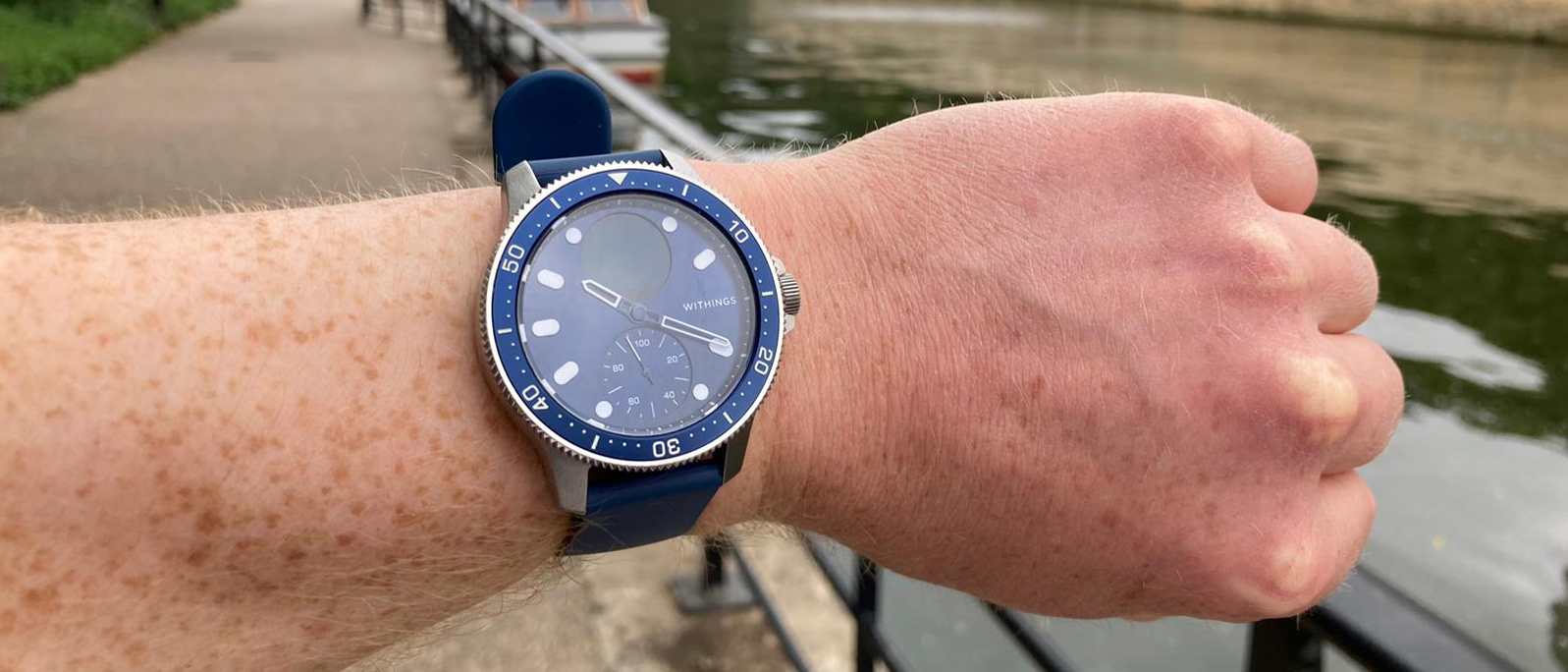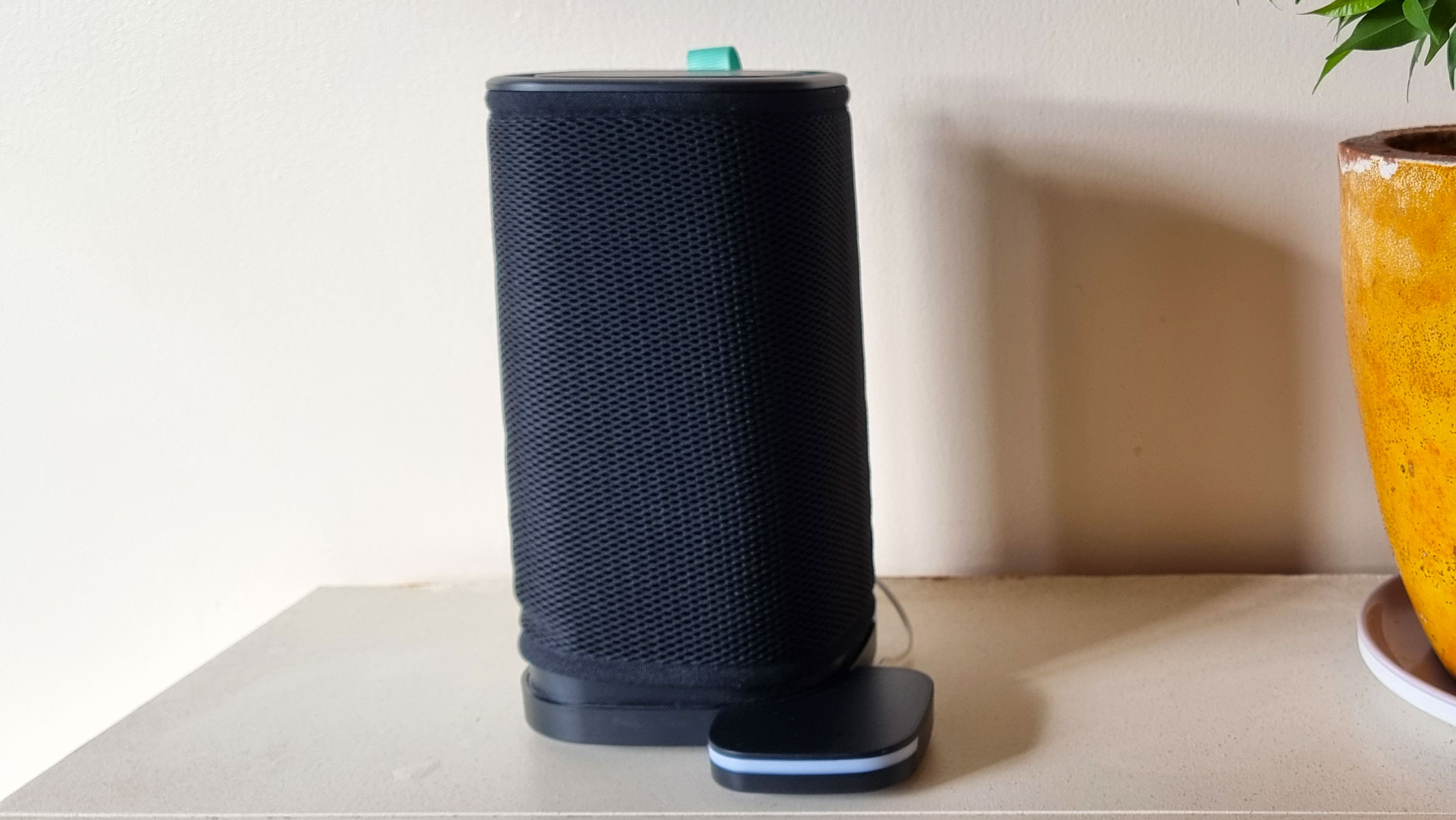Live Science Verdict
More of a stylish health monitor than a bona fide fitness tracker, the Withings ScanWatch Horizon is a thing of beauty that offers everything from the standard step counts to on-wrist ECGs, blood-oxygen saturation tests and atrial fibrillation (irregular heartbeat) alerts. Its fitness tracking capabilities can’t compete with dedicated sports smartwatches, but if you want an everyday wearable to keep tabs on your wellbeing, it won’t let you down.
Pros
- +
Stylish
- +
Discreet screen hidden behind a traditional watch face
- +
Up to 30-day battery life
Cons
- -
Exercise feedback isn’t detailed enough for stat-fiends
- -
No continuous heart rate tracking
- -
No in-built GPS
Why you can trust Live Science
No FitBit can truly be classified as a fashion statement, so we were overjoyed to get our hands on the Withings ScanWatch Horizon; a smartwatch that is, in fact, a smart watch.
Its sartorial elegance was the first thing to hit us, with its unrivaled sense of style propelling it towards our roundup of the best fitness trackers money can buy. However, look beyond its pleasing exterior and you’ll find this fitness tracker has more than a few tricks up its sleeve.
A small screen hidden within the top half of the watch face can be activated with a deft press of the watch’s crown. You can then twist the crown to flit through health-monitoring features like an on-wrist ECG, blood-oxygen saturation test and workout-tracking, as well as viewing your heart rate, daily step-count and distance traveled.
Software: Withings Health Mate app
Compatibility: iOS and Android
Battery life: Up to 30 days
Memory size:
Display: PMOLED
GPS: No
Water resistance: 10ATM
Heart rate: Yes
Sleep tracking: Yes
Music downloads: No
The watch can also be synced with the Withings Health Mate app to see a breakdown of your recent activity levels, review your sleep performance, and set daily movement goals to help you increase your NEAT.
When it comes to health-tracking and aesthetics, the Withings ScanWatch Horizon excels. Unlike most fitness trackers on the market right now, it prioritizes these elements over their eponymous task of fitness tracking – Withings prefers to describe their timepiece as a “hybrid smartwatch”.
For this reason, the fitness-tracking metrics (which don’t go much beyond heart rate and estimated calorie burn) are unlikely to be detailed enough for ardent exercisers, who may look instead to the Whoop 4.0 or Garmin Fenix 7 for feedback that can give them a competitive edge. But if you want an everyday fitness tracker that will monitor your health and motivate you to move without cramping your style, the Withings ScanWatch Horizon fits the bill to a T.
Price and release date
Released on May 17, 2022, the Withings ScanWatch Horizon is the French brands’ latest offering to the saturated smartwatch market, and we think they’ve done a fine job at standing out from the crowd. It costs $499.95 or £499.95 in the UK.
Design and display
Let’s not prevaricate here, the Withings ScanWatch Horizon is a beautiful bit of kit. Both the blue and green colorways cut a classy outline on your wrist, with the option to choose between an oyster metal chain or a fluoroelastomer strap meaning it can be worn for any occasion – whether you’re attending a wedding or plunging into a pool for a few lengths.
This isn’t a case of style over substance either. The Horizon benefits from some considerable upgrades over the standard ScanWatch, including 10 ATM water resistance, a rotating bezel and Luminova indexes. Or, in English, it can withstand pressures equivalent to a depth of 100 meters and the hour markers on the watch glow in the dark – handy for early morning wake-ups and water-based workouts.
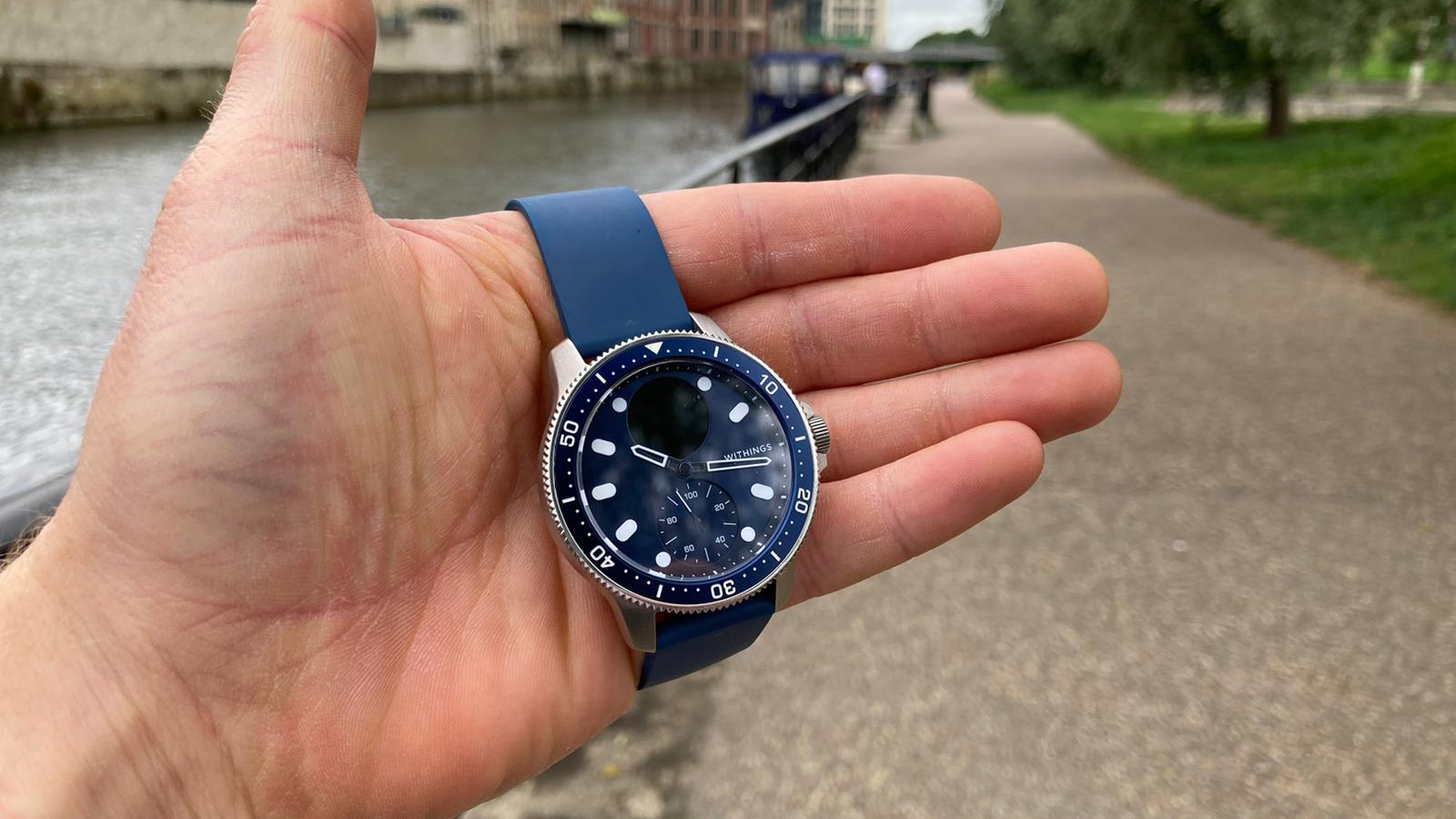
It also has a robust stainless steel case and a sapphire glass screen that withstood wild swims and clanging kettlebells without suffering as much as a scratch during our tests.
These features do mean the watch is on the heavier side at 72g, not including the strap, so it may not be one for keen runners or other endurance athletes looking to shave seconds off their time as they push for PBs. If you do wear it for higher impact activities, you’ll want to make sure the strap is pulled particularly tight to stop any unwanted movement of the watch face on your wrist.
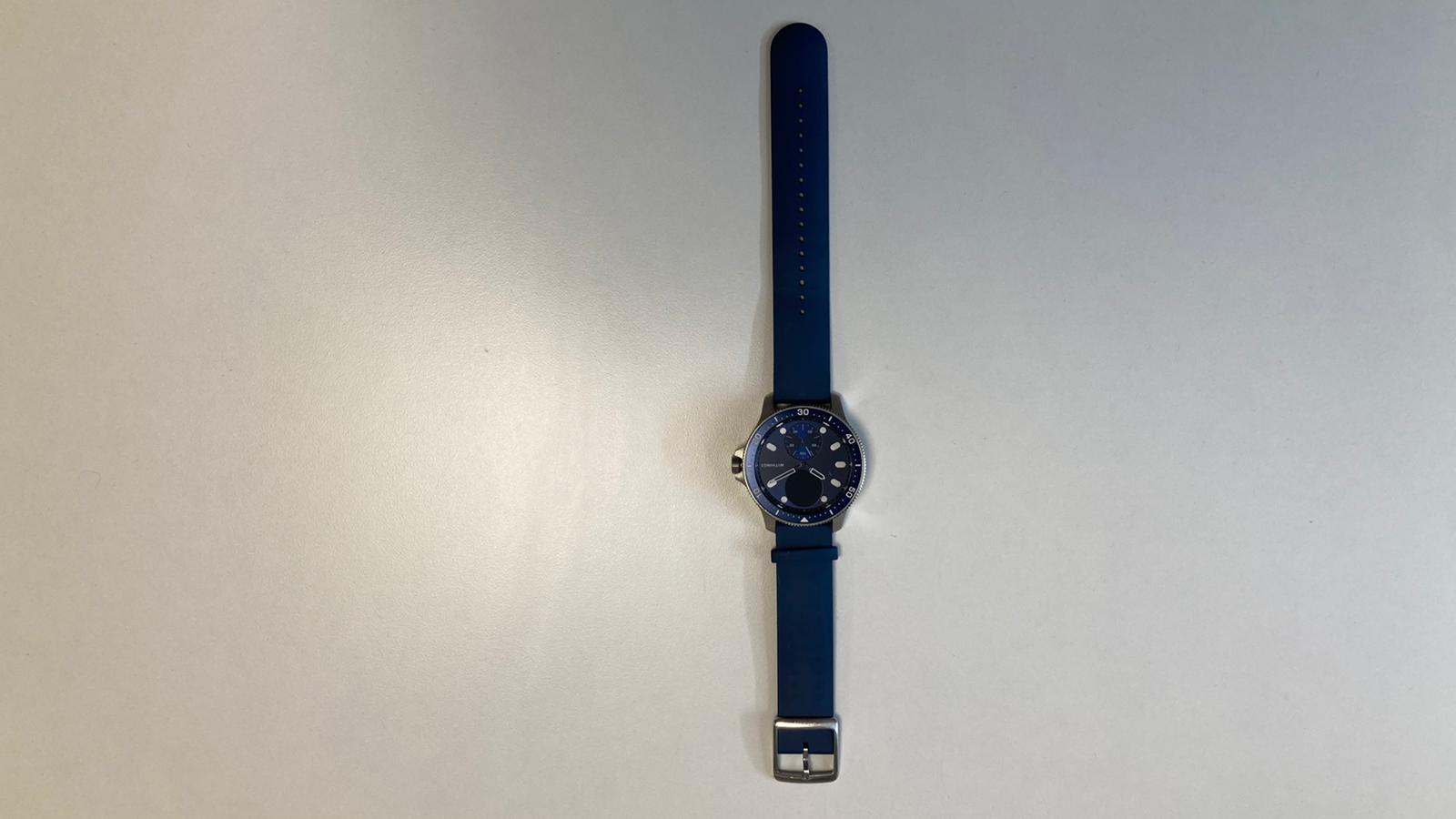
Never ones to conform to the fitness tracker norm, the Withings ScanWatch Horizon’s PMOLED display was also like nothing we had seen from a smartwatch before. While big-hitters like the Apple Watch Series 7, Garmin Fenix 7 and Fitbit Sense have touchscreen faces that can be consumed by features and metrics, the health monitoring credentials of the ScanWatch Horizon are far more subtle.
To look at, it initially presents as a classy diver’s timepiece. Only when you click the crown will a small circular screen in the top half of the watch face light up to display its health and fitness tracking functions. This can also be set to show previews of phone notifications. So, if you’re wanting a wearable that slots seamlessly into your 9-5 ensemble, you can look good while keeping tabs on your health on the sly.
There is also a small clock-like dial in the bottom half of the face that counts up to 100. This displays the percentage of your daily step goal you’ve completed, which we thought was a nifty addition as it allowed us to check our movement habits at a glance.
Features
The Withings ScanWatch Horizon has plenty of features to aid anyone aiming to increase their activity levels in order to boost their fitness or create a calorie deficit.
It can provide feedback on your daily steps, distance covered, floors climbed and heart rate, as well as offering on-wrist ECG (electrocardiogram) and a blood-oxygen saturation test in just 30 seconds.
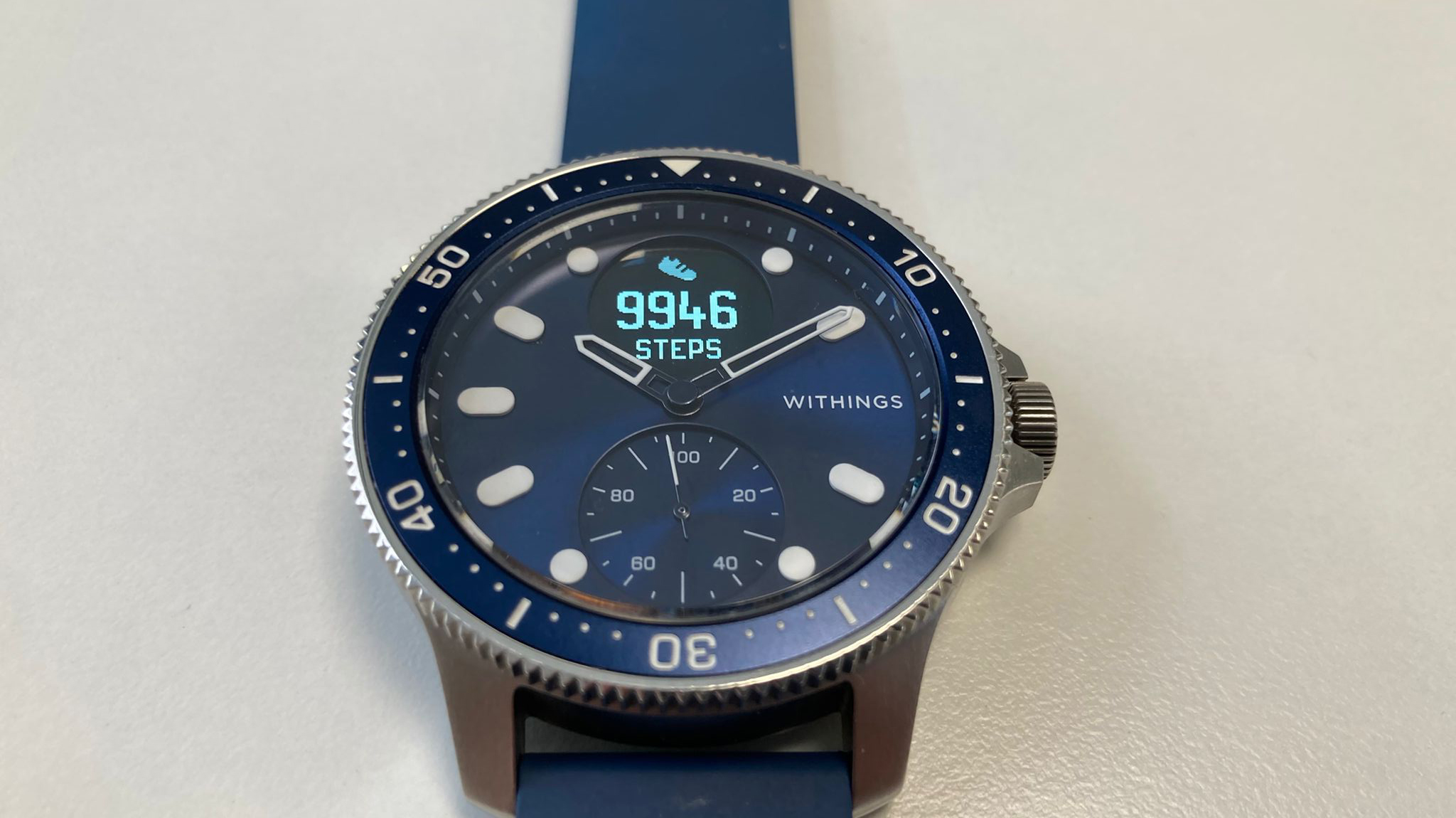
The ScanWatch can track specific activities too, with options to monitor running, cycling, swimming, walking or “other” using the crown. In the app you can be more specific than “other”, selecting from more than 40 activities including gaming, golf and handball.
You can also link to the Withings Health Mate app to find out more about your recent activity, with feedback and figures on your sleep performance, average heart rate, average asleep heart rate and estimated calorie burn.
We enjoyed the easy-to-use app, which has a handy induction to explain each of its features and a chatbot/coach who will regularly share science-backed health wisdom based on your habits.
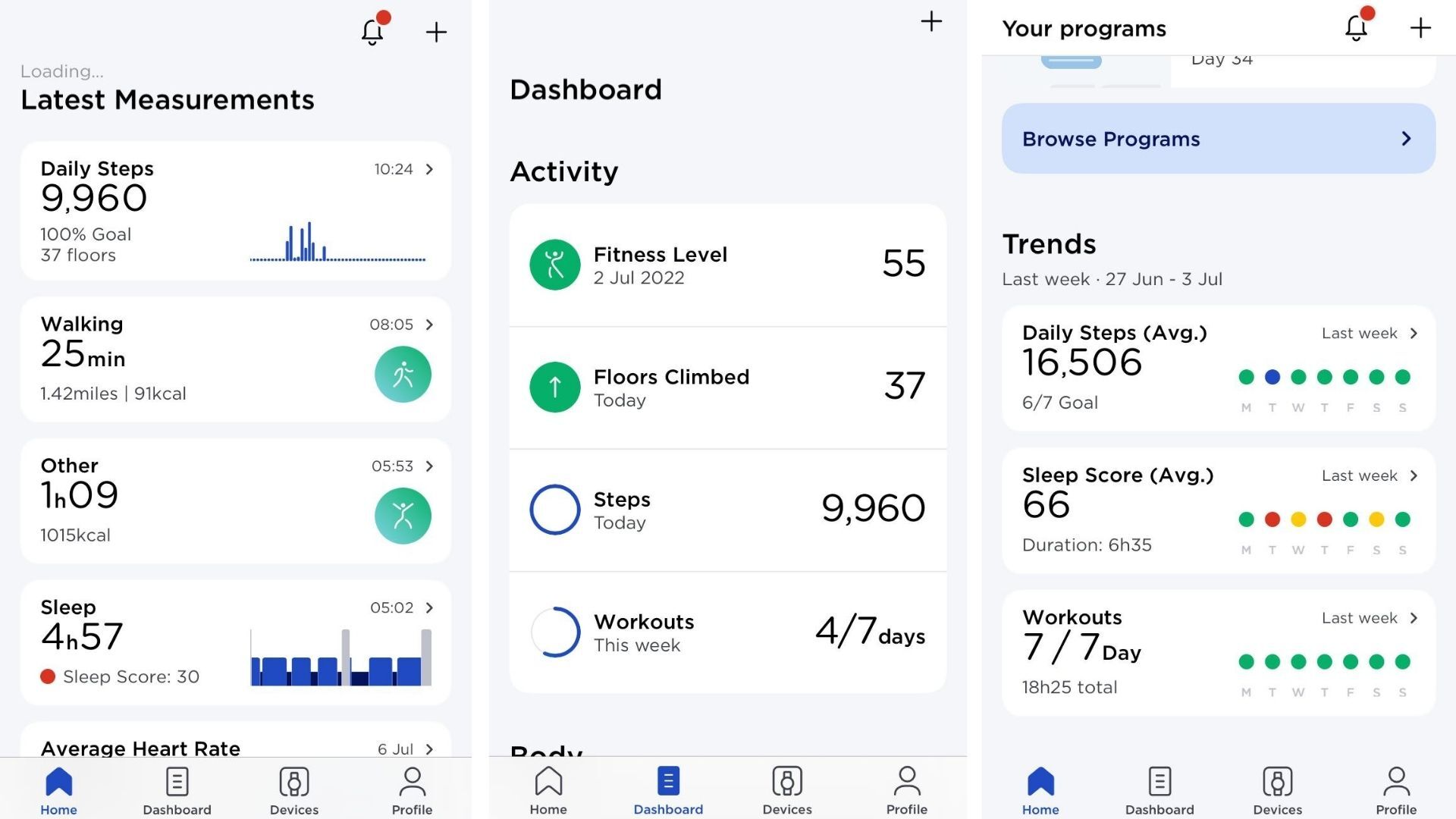
The app’s homepage presents your data as a scrollable thread, with the most recent activities placed nearest the top – much like a social media feed. Your daily steps are displayed as an accessible bar graph, and you can choose a target number of steps and weekly workouts, with your progress shown on the app’s dashboard as rings you have to close (a leaf taken firmly from the Apple Watch playbook).
The watch will even keep an eye on other health factors, such as signs of atrial fibrillation (irregular beating) and breathing disturbances (when someone experiences reduced or paused breathing while sleeping). And, while it specifies that it can’t detect heart attacks and you should visit a doctor if you feel unwell, we still appreciated the fact it goes the extra mile as far as health tracking is concerned.
We liked the sleep tracking too. Your time between the sheets is broken down into awake, light and deep or REM (rapid eye movement) phases, with a score awarded out of 100 based on your overall sleep time, depth, regularity and number of interruptions. This was a simple way to display complex data, which we appreciated when groggily scrolling through the app as our digital cockerel crowed.
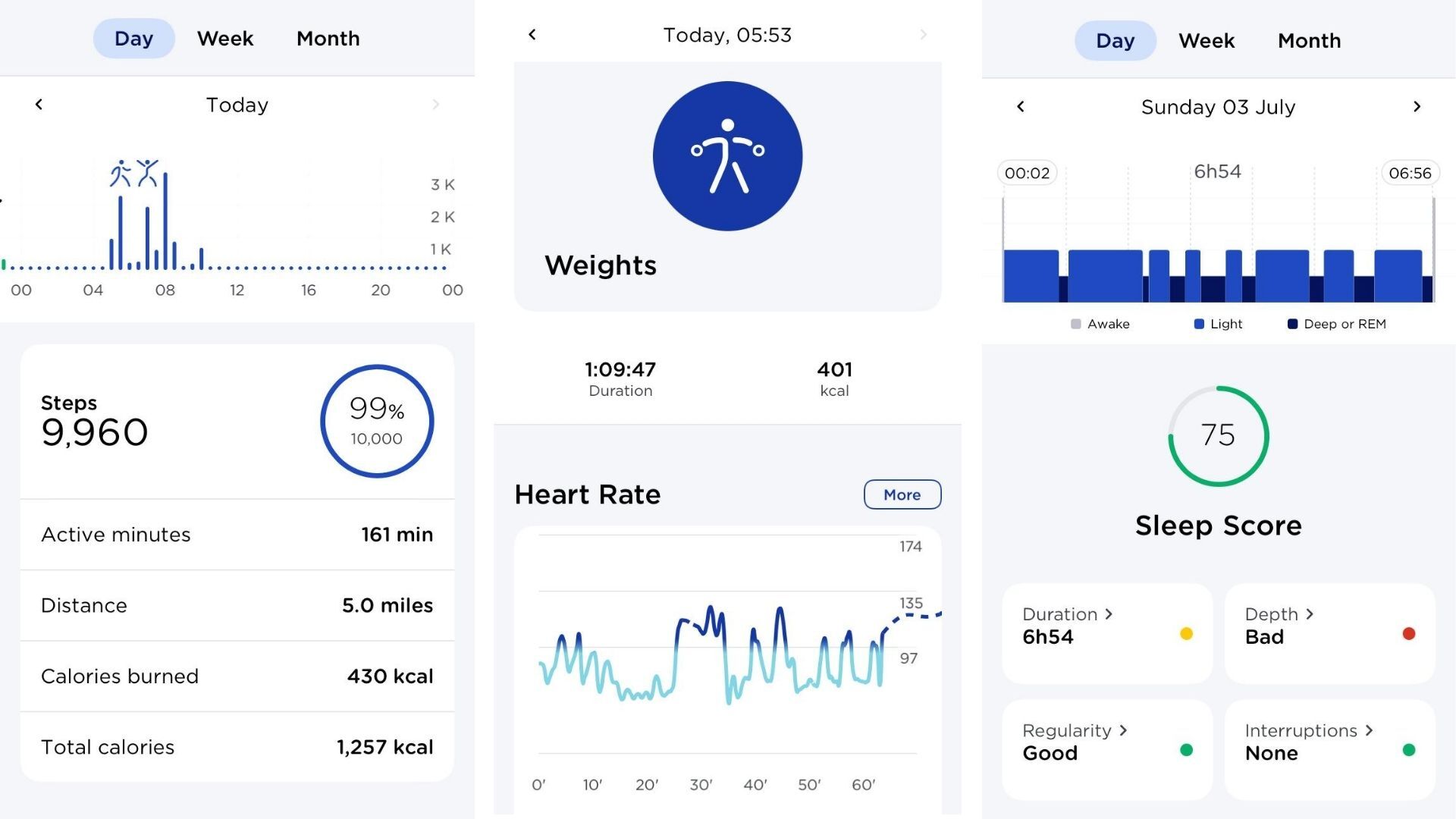
However, having trialed the no-nonsense Whoop 4.0 shortly before our Withings test, we found the fitness data on offer from the ScanWatch Horizon was tailored more towards those looking to get moving to improve their health rather than regular exercisers seeking actionable performance feedback.
The Whoop 4.0 offered digestible daily scores based on your recovery and daily strain – calculated using in-depth metrics like heart-rate variability and heart rate zones – which could be used to inform how hard you trained (or rested) that day to ensure optimal performance. Whereas, the ScanWatch Horizon’s data is more health-oriented, focused on step counts, daily activity levels and tests such as ECGs and blood-oxygen saturation.
This is a fantastic motivator for someone looking to increase their total daily energy expenditure to aid body recomposition goals such as losing weight. However, the sport-specific feedback on our exercise sessions was limited, with the data provided after gym sessions not going much beyond our heart rate, estimated calorie burn and time spent working out.
The heart rate tracking is only continuous when you set the watch to record a workout, with your pulse recorded every 10 minutes otherwise, and there is no in-built GPS. So, if you want to track the distance of a run, walk or cycle, you’ll have to have your phone handy with the app linked to the fitness tracker.
Again, this may only be a problem if it’s sport-specific feedback you want from your fitness tracker. If you want a stylish timepiece that offers a solid smorgasbord of health metrics detailing your daily activity levels and sleep patterns, the Withings ScanWatch Horizon won’t disappoint.
Performance
Overall, we were left impressed by the performance of the Withings ScanWatch Horizon, both as a robust watch and as a health tracker.
Originally concerned the design could be too style-oriented and wouldn’t be able to withstand our weekly cocktail of wild swimming, CrossFit and more as a result, we were blown away by its resilience. The stainless steel case and sapphire screen emerged unscathed from sessions where they were battered by rocks, barbells and bumper plates, among other unforgiving inanimate objects.
Equally as impressive is the fact that, in our two months of testing, we didn’t come across a single moment of difficulty or technical hitch. The watch and app are delightfully simple to use, and the app’s comprehensive induction helped to fill in any gaps in our knowledge when it came to getting the most out of the product. The coach feature is a nice add-on too, providing helpful personalized health insights.
The PMOLED display is simple, easy to read and discreet - ideal for anyone who wants to track their activity without swapping their usual time-keeper for a square, space-age looking pod – again, looking at you, Apple. And, despite the fact you can only press or twist the crown, the intuitive controls are surprisingly versatile for seeing your stats.

The minimalist display and controls may play a large part in the ScanWatch Horizon’s lengthy battery life of up to 30 days (depending on how often you are using its specialist features). In the 50 days we were testing the watch, we only had to fill the tank twice, with the battery hitting 100% after around three hours of being plugged in – figures which put the Apple Watch Series 7’s single day battery life in the shade.
We did find the 72g watch slightly heavy for endurance based exercises like running or more intense workouts, and while any impact of the weight on our performance is debatable, we were always acutely aware of its presence on our wrist. We also found we had to tighten the strap slightly more than we would have liked to ensure the watch didn’t slip or bounce around when exercising. This could become slightly uncomfortable during particularly sweaty sessions.
Another issue we discovered was that when our hands bent backwards during exercise (for example, when performing front squats with a barbell in the front rack position) our wrists would press down on the watch’s crown, pausing the watch’s workout-tracking.
When it came to the feedback on offer, the ScanWatch Horizon offered an accurate step count and advanced health features such as on-wrist ECGs, blood-oxygen saturation tests, atrial fibrillation monitoring and sleep tracking. It even provides an overall fitness score after some exercise sessions, calculated using your VO2 max.
These figures are great for keeping an eye on your wellbeing and overall daily energy expenditure, which may be priorities for those looking to live a less sedentary lifestyle or lose weight. However, keen athletes seeking tips and data to improve their performance may want more of a fitness focus from their tracker – such as continuous heart rate monitoring, heart rate variability tracking, and an in-built GPS.
Verdict
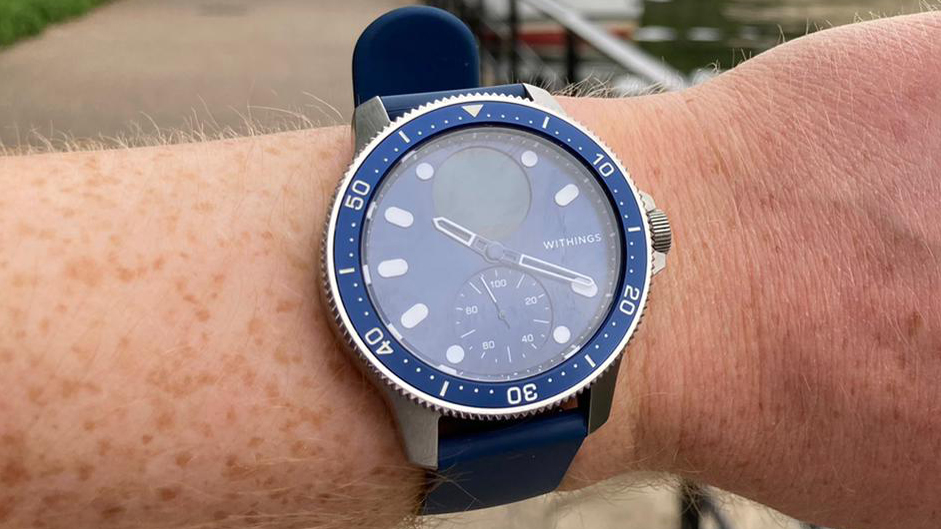
Though it’s a point of opinion, it’s hard to argue against the Withings ScanWatch Horizon being the best-looking fitness tracker on the market by some distance. The clean diver’s watch-like design and provision of a classy oyster metal chain (as well as a fluoroelastomer strap for sweaty sessions) means you can wear it for any occasion. We think this makes it a fantastic option for anyone wanting to keep an eye on their health without sacrificing style.
Its health-tracking credentials are enviable too, offering the standard metrics like step-counts, distance covered and floors climbed alongside more advanced tests like ECGs and blood-oxygen saturation.
We were somewhat underwhelmed on the fitness tracking front, with most activities only providing data on our heart rate and estimated calorie burn. And, when completing activities like running, the lack of an in-built GPS meant we needed to have our phone handy and linked to track our route.
But this only goes to show what the Withings ScanWatch Horizon was born to do: provide a good level of health metrics during everyday wear, while elevating the style points of the wearer. And in this role, it is nothing short of fantastic.
Alternatives
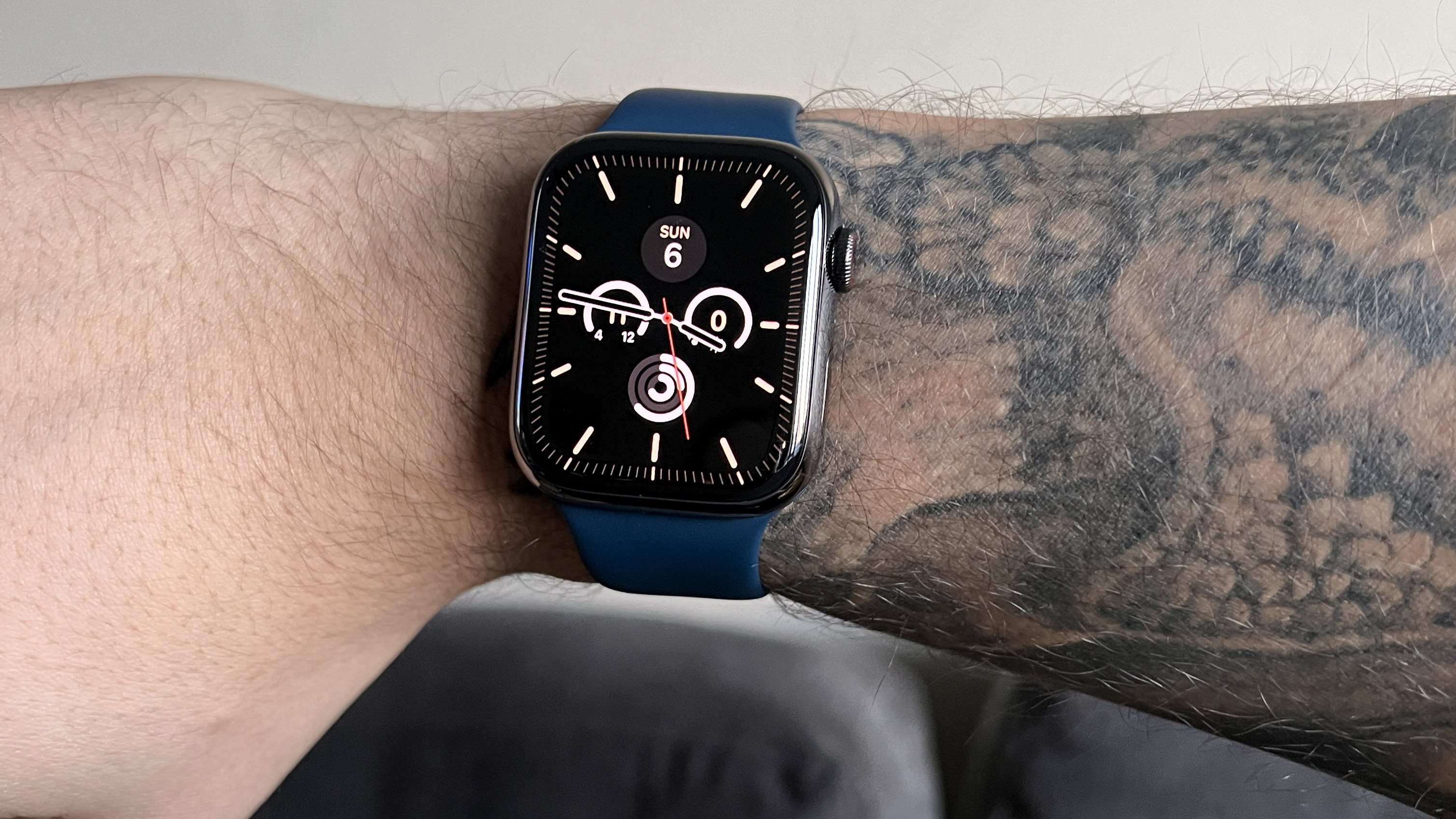
While it may be a predictable outcome, the Apple Watch Series 7 (above) wins the day when it comes to our roundup of the best fitness trackers. Unlike the Withings ScanWatch Horizon, it offers a responsive touchscreen and an expansive selection of apps available to download, allowing it to cater to most fitness needs.
Or, if you’re a hardcore athlete looking to optimize your performance, the Whoop 4.0 may be the right wrist-worn fitness tracker for you. This screenless band is designed to minimize mid-workout distractions, linking to an app on your phone post-workout to deliver detailed feedback on your activity strain and recovery levels.
How we test
As fitness writers, we put the best fitness trackers to the test the only way we know how; incorporating them into our everyday lives and training routines for more than a month. During this time, we trial every feature they have to offer while also seeing how the feedback they provide benefits both our daily health habits and sporting performance.
We reviewed each fitness trackers’ design and display, features, and performance, collating our feedback in these three areas to award them a final mark out of five.

Harry Bullmore is a fitness writer covering everything from reviews to features for LiveScience, T3, TechRadar, Fit&Well and more. So, whether you’re looking for a new fitness tracker or wondering how to shave seconds off your 5K PB, chances are he’s written something to help you improve your training.
When not writing, he’s most likely to be found experimenting with a wide variety of training methods in his home gym or trying to exhaust his ever-energetic puppy.
Prior to joining Future, Harry wrote health and fitness product reviews for publications including Men’s Health, Women’s Health and Runner’s World. Before this, he spent three years as a news reporter with work in more than 70 national and regional newspapers.
